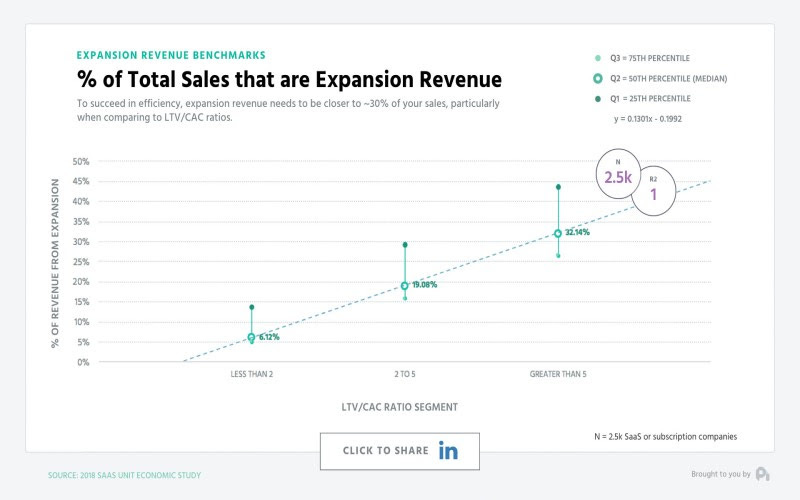Why expansion revenue equals symbiosis
Metric Stack 12: Grow with your customers, not through them. And vice versa
Hear me out. Revenue earned from existing customers is even more important than acquiring new customers. I say this with so much certainty because I (and many folks before me) have done extensive research on the factors that make expansion revenue such a crucial part of the MRR Equation.
Welcome to Metric Stack. I’m Priyaanka Arora, your personal metric assistant and Content Researcher and Writer at Klipfolio. In this edition of Metric Stack, we’ll go down the rabbit hole of expansion revenue and how it can help build a symbiotic relationship with your customers.
What is expansion revenue?
Expansion revenue is revenue made from up-sells and cross-sells. In other words, expansion revenue is generated from your existing customers in new ways. It forms an important part of your Monthly Recurring Revenue (MRR) along with new MRR, reactivation MRR, contraction MRR, and churned MRR.
On its own, expansion revenue helps you track how much money is being generated from existing customers who have decided to expand their usage of your product. However, when combined with other metrics and looked at through several different angles, expansion revenue can help you forecast your company’s growth. Here are two metrics that highlight the importance of expansion revenue:
Expansion Revenue as a Percentage of New Revenue: Divide your expansion revenue by total new revenue and you get the percentage of all new revenue that is earned through existing customers. Use this metric to measure how your expansion strategy is adding to new revenue growth. Here’s the formula:
Expansion Revenue as a Percentage of New Revenue = Expansion Revenue / New Revenue
Expansion MRR Growth Rate: This is the rate at which expansion revenue is added to total MRR, expressed as a percentage. This is a useful tool to fight churn. If this metric trends upwards over time in combination with expansion revenue as a percentage of total revenue, it’s likely you’re reducing CAC while increasing revenue. And that’s a good thing! Here’s the formula:
Expansion MRR Growth Rate = Expansion MRR in period / Total MRR at beginning of period
Now that you’re equipped with the basic definition and two useful metrics to measure the impact of expansion revenue on your business, let’s look at some benchmarks.
What’s a good expansion revenue benchmark?
Although most SaaS businesses report that 10% of their sales comes from expansion revenue, research suggests that expansion revenue should make up close to 30% of your total MRR.
Your key takeaways from this study should be:
When your expansion revenue percentage of total revenue increases, your LTV/CAC Ratio tends to increase, meaning your initial investment in your customers is paying off. Makes sense right? Expansion revenue comes from your existing customers, so naturally, your customer acquisition cost will be compensated in multiples.
Your customers grow with you, not just through you, when you focus on expansion revenue. Growth can only happen through balance between costs and returns. High expansion revenue indicates that you’re achieving growth by offering increasing value to your customers.
Why expansion revenue equals symbiotic relationships with customers
Isn’t it the ideal we dream of? As a founder, leader, salesperson, marketer, or other professional, tell me if anything would make you happier than a relationship where customers show their trust and satisfaction in your product while you see increased revenue, efficient LTV/CAC, and reduced customer churn.
No matter what that looks like in your business, whether it’s premium features, plan upgrades, or one-on-one training, your customers get improved product experience and functionality. If done right, you’ve given the customer a fresh reminder of why they invested in your product in the first place. You’ve secured a loyal customer who is less likely to churn and more likely to recommend your product to their network.
A symbiotic relationship is one where both parties benefit mutually, so let’s look at how a high percentage of expansion revenue benefits you. If you’ve read even casually through my three part Metric Stack deepdive into customer acquisition cost and its perils (read part one, two, and three of CAC Deepdive), you’ll recall how CAC has been named and shamed as the startup killer. In short, CAC can be so high that you don’t recover the costs in time to save your business. That’s where a well developed and executed expansion strategy can be your savior.
Think about it: you don’t have to start fresh with your existing customer base. They’re aware of who you are and have had a taste of how your product can improve their life. They’re bound to be curious about how they can get further value for their money and time invested in you.
You’re almost obligated to show existing customers how they can get more from you if they’re willing to invest more. The catch? Sustained growth through expansion revenue depends on high quality up-sell and cross-sell offerings that truly add value to your product experience.
Metric Stack is inviting guest writers!
With a steadily growing number of subscribers (900+) you’ll have a ready audience eager to hear what you have to say. Share a quote, a recommended resource, or a story - it’s up to you. Get your website or social media profile featured in return. We'll promote your contribution and give you a shout-out to our 35K+ engaged social media followers. Comment on this post or email me to learn more.
Stay tuned for the next edition of Metric Stack Newsletter to get the latest scoop on all things metrics! Send feedback, comments, questions here: parora@klipfolio.com


